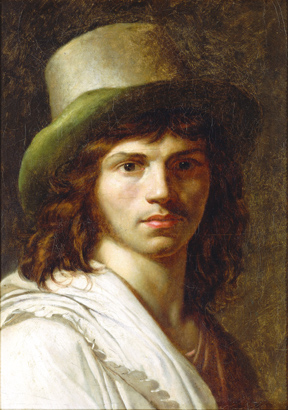Anne-Louis Girodet-Trioson
at
The Metropolitan Museum of Art
(photos courtesy of the Metropolitan Museum of Art)
By
RAYMOND J. STEINER
ART TIMES July/August
2006
WERE
IT TO consist of only the small oil entitled “Aurora and Cephalus”,
this exhibition* featuring the work of Anne-Louis Girodet-Trioson would
surely convince us that we were in the presence of a master painter.
Diminutive — at least in comparison to his major canvases —
Girodet’s little study (as he himself would have undoubtedly characterized
it) bodies forth all those qualities that art lovers once considered
ought to be present in the work of an accomplished painter: masterful
composition, superb draftsmanship, fluid brushstroke, color harmony
and, what has become a neglected element in our time, something to convey
to not only the senses, but to the mind as well. In brief, it is, above
all else, a “painting” — and for that, it brings delight to the
viewer. On the downside, however, for all its modest size, “Aurora and
Cephalus” dramatically brings home how much we have lost since artists
elected to turn their backs on the rigors of academic training.
We are fortunate, however, that “Girodet: Romantic Rebel” offers us much more to go on. A joint effort by the Cleveland Museum of Art, the Musée du Louvre, the Réunion des nationaux, the Art Institute of Chicago, the Montreal Museum of Fine Arts, the Musée Girodet, Montargis (Girodet’s birthplace), The Metropolitan Museum of Art and supported by The Isaacson-Draper Foundation and the Federal Council of the Arts and
Humanities, this major retrospective (the first of Girodet’s
oeuvre in the United States) is comprised of some 110 paintings and
works on paper, all of which afford us more than ample material on which
we might base our findings and form our judgments. It is heartening
to see such support for this exhibition and The Metropolitan Museum
of Art deserves special praise for bringing it to viewers in the Northeast.
For those cognizant of the history of western art, it is an exhibition
that might serve as not only an admonition for the current-day art viewer
/promoter /patron /historian /critic, but an indictment on the shameful
cultural level of what we indulgently call our current “artworld”. I
am less confident of the effect — if any — that the exhibition
might exert on contemporary artists.
Well-nigh overwhelming in his range of painterly virtuosity, Anne-Louis Girodet-Trioson is a supreme example of what it meant to carry the title of “artist” back in the days when to call oneself a “painter” meant a considerable amount more than it means today. In the heydays of France’s prestigious Prix de Rome and its official Salon — and especially of its premier painter of the era, Jacques-Louis David — a would-be painter was expected not only to give evidence of mastering his trade, but also of having a thorough first-hand familiarity with the classics through a direct reading of them in their original Latin or Greek. étienne Jean Delécluze, David’s biographer, noted that the painting master, in spite of his observation that Girodet was trop savant pour nous (too learned for us), “understood teaching to involve the development of artistic intelligence rather than the transmission of a style of painting”.1 It was an age when Michelangelo’s dictum that, “…si dipigne col ciervello et non con le mani” (one paints with the brain and not with the hands), still had a certain currency, an age when the artist was not exempt from accomplishing more — much more — than the expert wielding of a brush or a chisel. At the very least it was expected that the artist could — and would — read. Indeed, even if one were not destined to become a painter, it was still assumed that to consider oneself a true “citizen” in this pre-Revolutionary, “neo-classical” age, a knowledge of the classics — and at least a smattering of Latin and Greek — was a given. To more than a few, it was what being an adult implied.
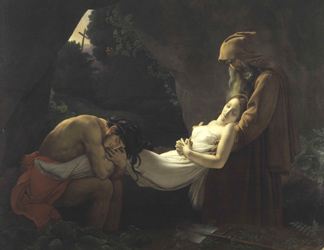 The Burial of Atala 1813 (repetition of 1808 original) Oil on canvas 82 3/4 x 105 1/8 in. (210.2 x 267 cm) Musée Girodet, Montargis. |
That Girodet seriously worked at (and thought about)
his craft, is fully evidenced in the exhibit, a wealth of preliminary
drawings and/or oil and watercolor sketches showing just what pains
he took to produce a “showable” piece worthy of having his signature
appear somewhere on its face. The “Academy” — a meticulous drawing
of a male or female nude — is well represented in this show as
might be expected, but there are also such things as a drapery study
(Catalogue #50) in black crayon and white chalk as well as numerous
detailed compositional studies for larger works (such as the intricately-wrought
black crayon sketch for “The Tempest” (Catalogue #121)) that prove just
how diligent Girodet was in mastering the tools of his trade. Who could
not admire the mind and hand that created the jewel-like preliminary
sketch for “The Revolt of Cairo” (Catalogue #57)? Or the four paneled
“Sketches for the Four Seasons” (Catalogue #38)? Little wonder that
his death was bemoaned by his colleagues and that, in spite of this
retrospective heralding him as a “Romantic Rebel” who ushered in a new
crop of painters, Jean-Antoine Gros was heard crying out at his funeral,
“Soon they will want us to believe that fifteen days of scribbling color
on a scrap of canvas can produce masterpiece …”2 (Fifteen days! It would
be interesting to see how many artists today spend that much time on
a single painting). Even then, in 1824, the year of Girodet’s death,
Gros was decrying the young, upcoming Eugène Delacroix’s “Massacre at
Scio” as “the massacre of painting”. It did not matter that Delacroix
admired — even emulated — David and his prize-winning pupils;
discerning painters were already convinced that they were witnessing
a downhill trend in the craft (something that Delacroix himself recognized
in his own work and tried to emend by applying himself even more diligently
to the task of learning how to become a painter) and foresaw the corruption
of art and its making. What might such artists as David, Drouet, Girodet,
or Gros say of what passes for the painter’s art today? How might they
react to what is called “art instruction” in today’s schools. or to
what is now included in “art” museums? Would anything that passes for
“art” and “art criticism” today make sense to them?
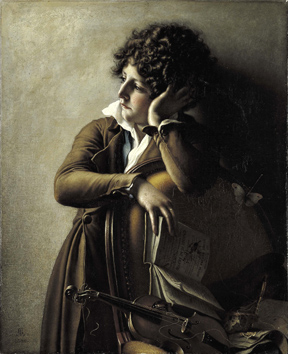 Portrait of Young Trioson 1800 Oil on canvas 28 3⁄4 x 23 3/8 in. (73 x 59.4 cm) Musée du Louvre, Paris. |
More, how might they have reacted to a conference I
attended some years ago at the National Sculpture Society when, at their
Centennial Anniversary, they were lamenting the fact that membership
was dwindling because today’s young sculptors were coming out of art
schools unable to sculpt a head? Of course, an art instructor’s task
is made considerably easier when such standards — any standards — are not part of the curriculum. Which brings to mind
Michelangelo again and how he had managed to carve, say, the Pieta or
David with the crude chisels and wooden mallets available to him. And
how do they compare — considering the pneumatic tools, compressors,
and power polishers now at their disposal — with the “assemblages”
of found objects, displays of bent or crushed metal, dissected livestock,
or knocked-together knickknacks concocted by present-day “sculptors”?
Surely there are a few “reactionaries” around today who are not taken
in by the glib wall texts, artists’ statements, and “critical” hogwash
that purports to “explain” what the so-called “art” so loudly proclaims
on its own terms. It either is or it ain’t — ‘nuff said. In Girodet’s
world, art had the onus of making sense on its own — in spite of the classical gloss imposed by the times —
and viewers didn’t have to be persuaded that there was actually a work
of art in front of them.
Oh, sure — our “focus” is different today. Art
has been “freed” from the constraints of such old-fashioned notions
as standards. Yet who can deny — contemplating even the “rough”
sketches of Girodet — that something has been lost since we so
cavalierly jettisoned standards? Even assuming that the present-day
viewer does not grasp the gist of the classical allusions Girodet is
making — he may not know the “story” — he is surely not
so dull-witted that he cannot see that there are recognizable figures
and forms before his eyes — and that these figures and forms are
rendered with consummate skill. One need only turn to the handful of
landscapes in the exhibition — “Landscape, View of the Alps”,
“View of Vesuvius and the Mas d’Anjou”, “Italian Landscape, View of
Capri” (Catalogue #s 15, 16, 17, respectively) — to know that
this is the work of a skilled painter.
And still it wasn’t enough that Girodet learned his
craft and applied himself to studying the classics (in the original,
remember!) — he was also a passable poet. In the end, however,
it didn’t really matter how much he read or how many prizes he won.
Nor did it ultimately matter that his subjects were drawn from classical
sources, or were erudite in their content. It didn’t matter whether
or not he contended with his teacher or his fellows, or as one essay
in the catalogue explores, if he might have been gay. In her essay,
“Is Endymion Gay”, Abigail Solomon-Godeau poses the question of whether
or not Girodet’s Endymion — a mythological character — was
gay and, of course, by extension, whether the same could be said of
Girodet. After weighing hypothetical pros and cons, Solomon-Godeau intelligently
arrives at the conclusion that the question is irrelevant and that,
“… Girodet, like any artist, is the subject through which passes, is
mediated and is filtered all that constitutes his temporal, cultural,
and historical circumstances and determinations”.3
In short, it didn’t matter if he was “trop savant”, a rebel, a sulker,
rash, petty, syphilitic, aloof, or whatever — the fact is he was
a painter and it is as painter that we ought to judge his work. And,
on that count alone, there were few who were his equal.
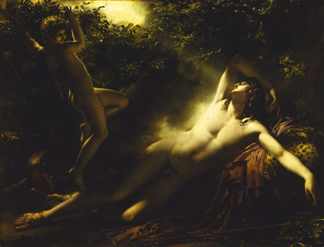 Sleep of Endymion 1791 Oil on canvas 78 x 102 3⁄4 in. (198 x 261 cm) Musée du Louvre, Paris. |
All the arguments against art being “shackled” by convention
notwithstanding, I wonder how many — artists included —
would trade his little “Aurora and Cephalus” for anything being produced
and hawked on the artmarket today? On the other hand, perhaps I ask
too much. We’ve come a long, long way from Bernard Berenson and his
idea of art being required to enhance our lives. To be “life enhancing”,
Berenson believed that art “must appeal to the whole of one’s being,
to one’s senses, nerves, muscles, viscera, and to one’s feeling for
direction, for support and weight, for balance and counter-stresses…”;
that life-enhancing art plunges us “into a state of being, or state
of mind, that makes one feel more hopefully, more zestfully alive; living
more intense, more radiant a life not only physically but morally and
spiritually as well; reaching out to the topmost peak of our capacities,
contented with no satisfaction lower than the highest…”; that “…art
as art, not art for art[my italics], must be life-enhancing…”;
and, finally, that art history itself “must be life-enhancing, life-expanding,
life-intensifying.” Speaking for myself, I was experiencing some form
of “life-enhancement” as I stood before such massive paintings as “The
Dead Christ Supported by the Virgin”, “Danaë”, “The Burial of Atala”,
“The Ghosts of French Heroes Welcomed by Ossian into Odin’s Paradise”,
and “Pygmalion and Galatea” although the equally large-scale “Napoleon
in Imperial Dress” left me somewhat cold. In fact, most of Girodet’s
portraits struck me as little more than formal exercises, with the exception
of “Portrait of Young Romainville Trioson” (to whom he had familial
connections and thus, more insight and empathy) and his “Portrait of
Cathelineau Generalissimo of the Great Catholic and Royal Army”, a particularly
handsome piece of painterly virtuosity.
However, we no longer live in Bernard Berenson’s world.
Whatever our threshold of excellence or significance might once have
been, it doesn’t take much today to impress us or to gain headlines.
One man’s life-enhancing treasure may be another’s life-depleting trash,
and with standards now out the window there is no way to determine —
other than by resorting to one’s opinion — which is which.
Aesthetics, as we have sadly come to learn, is not as certain as mathematics,
and quickly gets bogged down in problems of unremitting abstraction.
Most aestheticians today are in any event too busy firing off learned
salvos at their colleague’s last theories to pay much attention to what
is being called art nowadays — better to stay out of it and keep
one’s hands clean. Consequently, so-called “in-the-know, cutting edge”
cocktail party pundits are fond of smugly posing the question of who’s
to say what’s art and what’s not
— knowing that only the brave will attempt to bring up
the subject of standards. (I’ve been called an elitist — even
compared to Nazi/Communist totalitarians — more than once by letter-writers
to this publication whenever the “s” word appeared in my writing). By
and large, the story of the contemporary “art” scene is a sad affair
with gullible “curators” fresh out of college eager to show their liberal
range of taste (and yes, The Met has its share of them), a steady stream
of nitwits with more money than common sense only too eager to trumpet
to the world their abysmal ignorance and lack of refinement by hanging
junk on the walls of their homes and offices, and “art” dealers who
are, first and foremost, merchants who find their lives enhanced
by larger bank accounts, all too ready and willing to market whatever
sells.
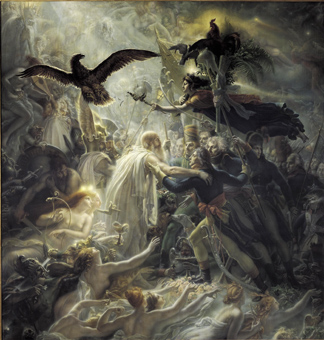 Ossian Receiving the Ghosts of the French Heroes 1801 Oil on canvas 75 5/8 x 71 3/4 in. (192.1 x 182.2 cm) Musée national des châteaux de Malmaison et de Bois-Préau, Rueil-Malmaison. |
On that note, “Girodet: Romantic Rebel” is a show that
few living artists who lay claim to that title might care to visit —
but the rest of us surely free to enjoy it at our heart’s content. Who
knows? After an hour or so of viewing the work of this consummate painter,
you might even find that your life has been a bit enhanced! At
the very least, an exhibit such as this can show what art could be if
pushed past the shameful limits of mediocrity to which we have allowed
it to descend — and whatever you might have to read about Girodet’s
work, it will be on what’s in it as opposed to the empty rhetoric
that tries to persuade you to see what is so obviously not in
a lot of the stuff out there today trying to pass itself off as real
art.
*“Girodet:
Romantic Rebel” (thru Aug 27): The Metropolitan Museum of Art, 1000
Fifth Ave., NYC (212) 535-7710 metmuseum.org. A sumptuous, fully illustrated catalogue accompanies
the exhibition: Girodet: 1767-1824 by Sylvain Bellenger (Curator at the Direction des Musées de France,
Paris) et al. 496 pp.; 9 ¼ x 11 ½; B/W & Color
Illus.; Appendices; Chronology on CD ROM (in French); $85.00 Hardcover.
(Gallimard: 2006).

